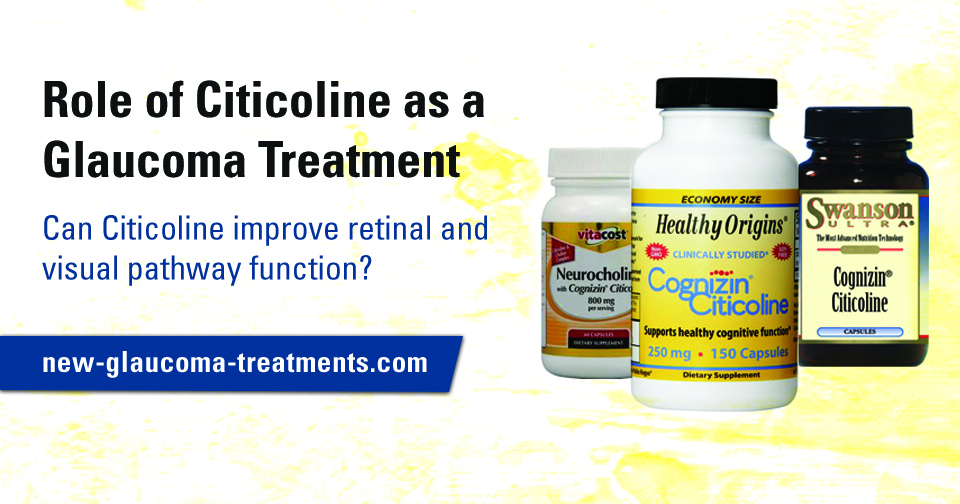What Is Citicoline?
Citicoline is naturally made within our own bodies. When taken orally it is broken down in the gut into smaller molecules that can be easily absorbed into the bloodstream. From the bloodstream these molecules can enter the brain where they are used to create phosphatidylcholine. The nerve cells in our brains need phosphatidylcholine to function properly. Additionally Citicoline may decrease the production of free radicals which would otherwise damage nerve cells.[1] In general Citicoline can be considered a neuroprotective drug.[2]
Evidence Supporting a Role of Citicoline in the Treatment of Glaucoma
The role of Citicoline as a glaucoma treatment has been studied with intramuscular[3], oral[4], and topical administration.
Intramuscular
Although not practical for most glaucoma patients, intramuscular injections (IM) of 1,000mg of Citicoline were compared to IM injections of placebo given over a course of 60 days.[5] Retinal and visual pathway functions were evaluated by visual evoked potentials (VEPs) and pattern-electroretinograms (PERGs). There was a significant improvement in test results noted in the IM Citicoline group compared to the group who received the placebo.
In another study, visual field improvement was noted after only a 10 day course of 1,000mg of intramuscular Citicoline.[6]
Oral
Because Citicoline is so well absorbed by the gut oral intake should have a similar benefit compared to intramuscular administration. There is one published study evaluating a small group of glaucoma patients who took an oral dose of 1,000mg of Citicoline daily. In most, but not all, of these patients the visual evoked potential (VEP) results improved after four weeks of treatment. Unfortunately there was no placebo control group in this study.
A separate study evaluated a proprietary oral solution of Citicoline. In this study 500mg per day appeared to slow the progression of glaucomatous loss of vision[7] over a period of 60 days.
Eye Drops
A preliminary study was published using an experimental eye drop solution of 2% Citicoline, 0.2% high molecular weight hyaluronic acid, and 0.01% BAK (OMK1, Omikron Italia s.r.l.). This study demonstrated that Citicoline is absorbed into the eye. Additionally, after 60 days of use in patients with glaucoma the retinal ganglion cell function improved.
Potential Side Effects and Risks of Citicoline
Citicoline appears to be safe and well-tolerated when taken by mouth.[8] The most common side effects are nausea and diarrhea.
Potential Drug Interactions of Citicoline
None known.
Recommended Dosage and Where to Buy
Citicoline appears to be safe in doses ranging from 1,000-2,000mg per day for short periods of time ranging up to three months.[9] It is not known whether it is safe to use over a gram a day of Citicoline for longer periods of time. Based on the limited available research, 500-1,000mg per day of Citicoline would appear to be necessary in order to achieve improvement in retinal and visual pathway function.
Citicoline can be found at most health food stores as well as online. Take note, however, that the quality can vary greatly. To be certain you are getting a high quality product that is formulated for maximum benefit I would recommend you only purchase supplements that contain the Cognizin(R) brand of Citicoline. Manufacturers that use Cognizin(R) Citicoline include Healthy Origins[1], Life Extension[2] , Swanson[3] , and Vitacost[4] .
References
1) Weiss GB. Metabolism and actions of CDP-choline as an endogenous compound and administered exogenously as citicoline. Life Sci 1995;56:637-60.Adibhatla RM, Hatcher JF. Citicoline decreases phospholipase A2 stimulation and hydroxyl radical generation in transient cerebral ischemia. J Neurosci Res 2003;73:308-15.
2) Grieb P, Rejdak R: Pharmacodynamics of citicoline relevant to the treatment of glaucoma. J Neurosci Res, 2002; 67:143-8.
3) Conant R, Schauss AG. Therapeutic applications of citicoline for stroke and cognitive function in the elderly: A review of the literature. Altern Med Rev 2004;9:17-31.
4) Rejdak R, Toczolowski J, Krukowski J, et al. Oral citicoline treatment improves visual pathway function in glaucoma. Med Sci Monit 2003;9:PI24-8.
Parisi, V., Coppola, G., Centofanti, M., Oddone, F., Angrisani, A. M., Ziccardi, L., Ricci, B., Quaranta, L., and Manni, G. Evidence of the neuroprotective role of citicoline in glaucoma patients. Prog.Brain.Res 2008;173:541-554.
5) Parisi, V., Manni, G., Colacino, G., and Bucci, M. G. Cytidine-5′-diphosphocholine (citicoline) improves retinal and cortical responses in patients with glaucoma. Ophthalmology. 1999;106(6):1126-1134.
6) Pecori-Giraldi J, Virno M, Covelli G et al: Therapeutic value of citi-coline in the treatment of glaucoma (computerized and automated perimetric investigation). Int Ophthalmol, 1989; 13: 109-12
7) Ottobelli L, Manni GL, Centofanti M, Iester M, Allevena F, Rossetti L. Citicoline oral solution in glaucoma: Is there a role in slowing disease progression? Ophthalmologica 2013;229:219-26.
8) Fioravanti M, Yanagi M. Cytidinediphosphocholine (CDP-choline) for cognitive and behavioural disturbances associated with chronic cerebral disorders in the elderly. Cochrane Database Syst Rev 2005;(2):CD000269.
9) Spiers PA, Myers D, Hochanadel GS, et al. Citicoline improves verbal memory in aging. Arch Neurol 1996;53:441-8.
Related Articles:
- Agmatine And It’s Potential Role In The Treatment Of Glaucoma
- Palmitoylethanolamide (PEA) Treatment For Normal Tension Glaucoma
- Glaucoma Supplements To Discontinue (Or Continue) Around The Time of Eye Surgery
- Antioxidants In The Treatment Of Glaucoma
- Vitamin D Deficiency And Glaucoma
- Vitamin E and The Treatment Of Glaucoma
Don’t delay getting checked for glaucoma.
Make an appointment with an eye doctor in your area now. If you live in the greater Los Angeles area and would like Dr. Richardson to evaluate your eyes for glaucoma call 626-289-7856 now. No referral required. Appointments are available, Tuesday through Saturday.



